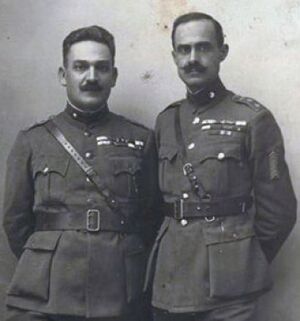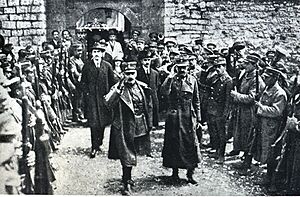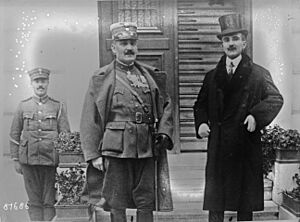Stylianos Gonatas facts for kids
Quick facts for kids
Stylianos Gonatas
|
|
|---|---|
| Στυλιανός Γονατάς | |

Stylianos Gonatas c. 1922
|
|
| Prime Minister of Greece | |
| In office 14 November 1922 – 11 January 1924 |
|
| Monarch | George II |
| Preceded by | Sotirios Krokidas |
| Succeeded by | Eleftherios Venizelos |
| Minister for Public Works | |
| In office 18 April 1946 – 24 January 1947 |
|
| Monarch | George II |
| Prime Minister | Konstantinos Tsaldaris |
| Personal details | |
| Born | 18 August 1876 Patras, Kingdom of Greece |
| Died | 29 March 1966 (aged 89) Athens, Kingdom of Greece |
| Resting place | First Cemetery of Athens |
| Alma mater | Hellenic Army Academy |
| Awards | |
| Military service | |
| Allegiance | |
| Branch/service | |
| Years of service | 1892-1922 |
| Rank | |
| Battles/wars |
|
Stylianos Gonatas (born August 15, 1876 – died March 29, 1966) was an important Greek army officer and politician. He served as the Prime Minister of Greece from 1922 to 1924. He was also a supporter of a political movement called Venizelism, which followed the ideas of the famous Greek politician Eleftherios Venizelos.
Contents
Early Life and Military Career
Stylianos Gonatas was born in Patras, a city in Greece. He joined the Greek Military Academy in 1892 and finished his training in 1897. As a young officer, he took part in the Macedonian Struggle between 1907 and 1909. This was a conflict where Greeks fought to free Greek-speaking regions from Ottoman rule.
He also served as an aide to Colonel Nikolaos Zorbas after the Goudi Revolt in 1909. This revolt was a military uprising that led to political changes in Greece. Gonatas also fought in the Balkan Wars (1912-1913) and in World War I. Later, he participated in the Asia Minor Campaign as a colonel. He started as a staff officer and then became a commander of a division.
The 1922 Army Revolt
In August 1922, the Greek army faced a major defeat in the Asia Minor campaign. This forced the army to leave Anatolia quickly. This defeat caused a big political problem in Greece. Soldiers who had been evacuated started revolts in cities like Thessaloniki, Chios, and Lesbos. These revolts were mainly led by officers who supported Venizelos.

The army groups on the island of Lesbos formed a group called the Revolutionary Committee. Colonel Gonatas was one of its leaders. They sent demands to Athens, the capital city. They wanted the government to resign, the Parliament to be closed, and new elections to be held. They also demanded that King Constantine I step down from the throne.
The revolutionary movement quickly spread across Greece. The Greek navy also joined their side. The government resigned right away. On September 27, King Constantine I gave up his throne for the second time. His son, Prince George, became the new King George II.

On September 28, the revolutionary troops entered Athens. They were led by Colonels Nikolaos Plastiras and Gonatas. People cheered them on with great excitement. The Revolutionary Committee took control of the country. They chose Alexandros Zaimis to be the Prime Minister. However, since Zaimis was not in the country, Sotirios Krokidas became the temporary Prime Minister.
Serving as Prime Minister
The first government formed under the Revolutionary Committee faced some changes. The committee was the real power in Greece, even with King George II on the throne. Sotirios Krokidas served as acting Prime Minister. After less than two months, his government resigned on November 24. This was mainly because of disagreements about the "Trial of the Six." This trial involved former government officials and military leaders.
On November 27, 1922, a new government was formed. This new government was made up only of members from the Revolutionary Committee and their supporters. Colonel Gonatas was chosen as the new Prime Minister.
The government led by Gonatas stayed in power until January 11, 1924. Then, he resigned, and Eleftherios Venizelos became Prime Minister. Venizelos had returned from Paris. For his service to Greece, Gonatas received a high honor called the Grand Cross of the Order of the Redeemer. On May 31, 1924, the National Assembly promoted Gonatas and Plastiras to the rank of lieutenant general.
Later Political Career
After serving as Prime Minister, Gonatas left the army. In the same year, Greece became a Republic. This meant Greece no longer had a king. The country's law-making body, the Parliament, also added a second house called the Senate.
Gonatas ran for the Senate as a member of the Liberal Party in 1929. He won the election, representing the areas of Attica and Boeotia. He was re-elected and later served as the President of the Senate from 1932 until it was dissolved in 1935.
During World War II, when Nazi Germany occupied Greece, Gonatas was held in the Haidari concentration camp for four months. After the Germans left Greece, Gonatas was freed and returned to politics. He formed his own political party called the Party of National Liberals. This party joined forces with the conservative People's Party for the 1946 general election. Gonatas's party won 30 seats in Parliament. He supported bringing King George II back to the throne, which happened after a public vote in 1946.
From 1946 to 1947, Gonatas served as the Minister for Public Works in the government led by Konstantinos Tsaldaris. In the 1950 general election, Gonatas's party allied with the Liberal Party. However, for the first time in his political career, Gonatas was not elected. He did not seek public office again after that. He continued to advise the King as a former Prime Minister until he passed away on March 29, 1966, in Athens.
See also
- Corfu incident


